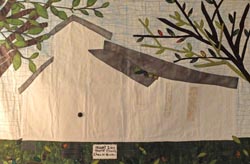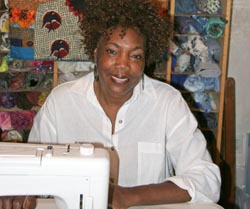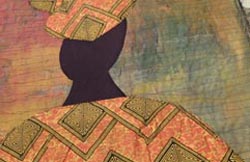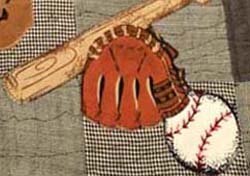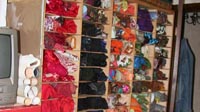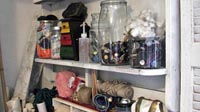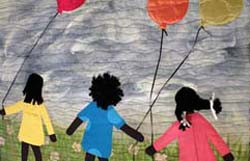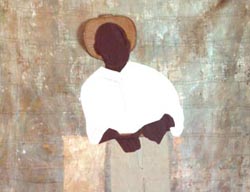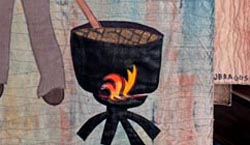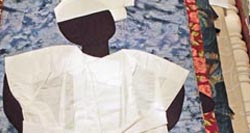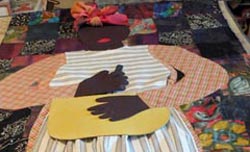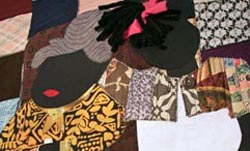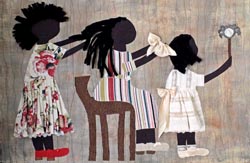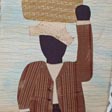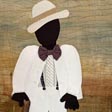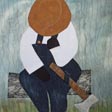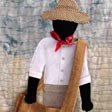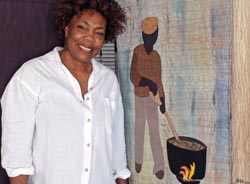Stitching Memories: Judith Braggs' Black Folk Art Quilts
By Laura Marcus Green
You always put your spin on whatever you do, you know.
—Judith Braggs
Starting Out in Cherie Quarters
Judith Braggs has fond memories of her childhood in Cherie Quarters, near New Roads, Louisiana. Situated on a former plantation, the small community centered on a gravel lane lined with cabins, leading to Mt. Zion Baptist Church and False River. Judith's family has deep roots in "Cherie" or "The Quarters," as she calls her hometown. "They've been living there forever, seems like," she says.
Judith and most of her eight siblings were born at home in her family's cabin, with the help of a midwife. Early on, Judith's father, Mose Braggs, Sr., worked for his uncle, a sharecropper, as well as other farmers. When Judith was four or five, her family moved to Port Allen, where she started school. In Port Allen, her father worked for a dairy. The family moved back to Erwinville, five minutes from Cherie, when Judith was in eighth grade. At that time, Judith's father did roadwork with a construction company. After Judith completed high school, the family moved permanently to Baton Rouge, to a subdivision near the Old Mississippi Bridge, walking distance from the welding plant where her father worked until retirement. Her mother, Beatrice B. Braggs, was a homemaker who raised eight children. Over the course of Judith's childhood, Cherie's population dwindled, as residents moved away to more populous areas in search of education and employment. Judith explains that as the older people died, members of her generation never thought of staying on to live in Cherie. But it is still home, a place where people return to visit, and plan on ending up, in the Mt. Zion Baptist Church Cemetery.
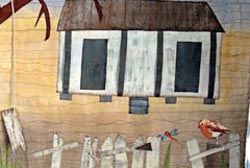
Today, all that remains of Cherie Quarters are the church, the cemetery, two cabins that are still standing, and surrounding land. The well-known Louisiana author, Ernest Gaines, is also a Cherie native. A contemporary of Judith's parents, Gaines and his wife acquired the church in order to preserve it. The Gaines relocated the church to their backyard, which is within walking distance of the Quarters, the community cemetery, and surrounding land. Each year in late October, the families who once called Cherie home reunite for All Saints Day, when they tend the cemetery grounds, add new plantings, and refurbish tombstones. Throughout the year, several men from the community keep up with the tall grass, but All Saints Day is a time when all of the families come together to care for the cemetery and to share fellowship and a community meal. Once the work is done, people go by the Gaines home for a feast of red beans and rice, gumbo, cornbread, and more. Judith's parents are gone now, but she and other family members enjoy attending these reunions each year.
Year round, Judith returns to Cherie Quarters by way of the quilts she stitches from colorful fabrics, three-dimensional materials, and her vivid memories of family, community, and the way of life in her childhood days. What began as way to have positive and appealing Black Art on her walls has blossomed into a passion and a business, Judith's Folk Art Quilts.
Quilts in the Family
Judith remembers the quilts from her childhood days.
Well, we had quilts because that's what we used to keep warm at night. But they were quilts that were so heavy, you could hardly turn over! You know, I don't remember seeing my parents make quilts, though, when we were growing up. . . . Yeah, we had them. Everybody had to sleep under them, that's the only way you could keep warm, because . . . the only heat we had was from the fireplace. So you had to have a quilt.
Judith does not know who made the quilts that covered the family's beds in those childhood days. She has heard that one of her grandmothers was a quilter, and wonders whether her own love of quilting might be a subliminal legacy passed down from an earlier generation. She has vivid memories, however, of how the quilts looked and felt. She recalls that they were, "Heavy. And I liked them. You know, they were just hand-stitched, heavy quilts. . . . What I remember are just blocks, you know, squares, just multicolored, bright colors. I don't know, maybe that's why I like bright colors, because most of my art is pretty bright." Judith thinks that these childhood quilts might have been filled with a batting of raw cotton, as that would have been plentiful on the plantation and would account for the quilts' lumpy look and feel. She still has a place in her heart for these older quilts and sometimes buys them at thrift stores and resale shops. As a quilter, she finds it hard to imagine why anyone would give away something that someone took the time and care to make.
A Seamstress Early On
With seven daughters at home, Judith's father purchased a sewing machine from a traveling salesman, thinking he might save a little money on the girls' wardrobes. In the end, Judith was the only one who fulfilled this investment. She learned how to sew in her high school home economics class, picked up some tips from the salesman who sold her family the machine, and supplemented her instruction with reading. Judith was in about eighth grade when she started sewing. Looking back, she recalls:
So I started making little skirts. I would make skirts, you know, just little gathers or little pleats, mostly for me and my girlfriend. But then, as I grew up, I kept sewing because I was tall and skinny. And you couldn't find clothes to really fit. You know, when your parents buy stuff, you wear it. But once you get to be a certain age, you want stuff to fit the way it's supposed to fit. . . . So therefore, I made all of my clothes until, oh, I don't know, I was probably way in my thirties before they started making pants, to me, that was long enough and that had pockets. I didn't like pants that didn't have pockets, so I used to make all my clothes.
Although she stopped making her own clothes when she began finding store-bought apparel to suit her taste and height, Judith's tailoring skills would come in handy later on. After working for the Louisiana Department of Revenue as a revenue accounts auditor for 32 years, she retired in 2005. Like many contemporary quilters, she benefited from having new-found time in which to pursue her art form.
Starting Out With Baby Quilts
Judith remembers the first quilt she ever made—a baby quilt for a nephew who is now in his mid-twenties. The beginnings of her unique style and quilting technique are evident in these early quilts, which date from the late 1980s or early 1990s. Judith's baby quilts have a foundation of pieced blocks, harking back to the quilts that covered her bed in childhood. The blocks became a canvas for appliquéd animal figures and alphabet letters—ABC's or a baby's name. Judith tied her baby quilts with brightly colored, contrasting yarns and quilted around the outlines of the shapes that she appliquéd onto the patchwork.
These early quilts were gifts that Judith gave to family and friends at baby showers. As others appreciated her work, she also received commissions and her baby quilts were soon in demand. After sewing her own clothes for so many years, making quilts was a natural leap for Judith. She taught herself to make quilts by looking in magazines and adapting what she saw to her own liking, as she had always done with clothing patterns. She explains that she learned by "seeing something that's already made and figuring you can do it and just do it your way. You always put your spin on whatever you do, you know."
Then as now, Judith was never a fan of ready-made batting. She soon developed her own technique of layering pieces of cloth between her quilt tops and backs. Depending on her desired weight for a quilt, she uses up to three or four layers of a cotton or cotton blend fabric. For this middle layer, she uses up the part of her stash she doesn't like—the fabric that she bought and later wonders why! This technique works well for her.
Judith's Black Folk Art Quilts: A Style All Her Own
Like her baby quilts, Judith's folk art quilts began in response to a need. She was in search of Black Art to decorate her home, but was unable to find artwork that appealed to her. As with the wardrobe she once made, she decided to make something that suited her taste and ideas. She explains:
I was looking for something to put on my wall, actually. And then I looked on the computer, I was looking at Black Art. I didn't really know a lot of artists. Now that I've been doing this, I see a lot of art that I do like. But when I was looking, I didn't see anything that I liked. So then I said, I would try to make something. And so I did make a piece, I made a lady. And I took it by one of my friends and asked her did she like it. I said, "Do you like this?" And she said, "Oh yeah," she said, "I want to buy it." And I say, "You'll buy this?" I said, "Do you think other people would buy this?" And she said, "Oh yeah, it's beautiful." So she bought the first piece that I made.
Judith's friend's enthusiasm was an impetus to continue making her folk art quilts, drawing upon childhood memories, family photos and stories, and images of life around her. Her very first quilt portrayed a woman. Judith recalls, "I wanted to do a lady. And that's how she came out. . . . She could represent any lady, doing anything." In her publication, Judith's Folk Art Quilts, Judith explains that "The Lady" "represents all women. Grandmother, Mother, God-Mother, Aunt, Sister, Sister-in-law, Cousin, and Friend. She is admired by all. She could be you or someone you know." (Braggs 2012: 30)
This quilt design, which Judith has made in variations over the years, leaves it to the viewer to decide who the "The Lady" is to them. When she sells her quilts, Judith often provides a tag containing the story that inspired her creation of a particular design. Yet, she also leaves room for her customers to find their own memories and meaning in her work. This is, in part, why the figures in her quilts do not have faces. She says:
I like 'em not having a face . . . 'cause when somebody else buys it, they can put a face on it, kind of. You know, a lot of times they'll say, "Well, this reminds me of so-and-so or of such-and-such time." So I think if it had a face on it, . . . it wouldn't resonate with them so much, you know what I mean?
At first glance, you might not notice that the figures in Judith's quilts have no faces. Perhaps because she is an accomplished seamstress who outfits her figures in tailored clothing, her quilts portray scenes that are expressive and lifelike, with a sense of movement. As she describes it, "You can kind of give them, like, a little attitude or a little personality by the way you do them or the clothes you put that you put on, or the hand shape, or the legs, or whatever." Judith's quilts are three-dimensional. She brings them to life through the outfits she sews for the figures, using textured fabrics, specialty prints, and skilled techniques like pleating, lace work, and custom-fit tailoring. The figures' straw hats and other elements are made from cloth, yarn, recycled placemats, cardboard, buttons, and whatever materials her imagination and well-stocked sewing room provide.
A visit to Judith's sewing room is a window into her process and technique. The walls of this cozy space are lined with carefully arranged fabrics, jars of buttons and all manner of notions—rolls of ribbon and lace, skeins of yarn and balls of twine, bunches of raw cotton, and more. Judith buys fabric from various sources—everywhere, she says. When she sees something she likes, or finds something on sale, she buys a little bit of yardage. She does not buy a lot of any one thing. Rather, she gathers smaller pieces of many different fabrics, to have a good variety on hand. Surrounded by these materials, she designs and creates vibrant portraits and scenes from her mind's eye and from photographs.
Judith's approach to quilt making varies. The backgrounds of Judith's quilts are often pieced from strips or blocks of fabric. Sometimes she reaches into her collection of old quilt tops that she has bought for a background that will work with a particular design. Another approach is to take a solid piece of fabric and either paint it or machine-stitch it with wavy lines (or both) to create the desired effect.
The quilt of girls playing with balloons is a good example of the solid-fabric techniques. From there, she sews together the layers of fabric that serve as the batting and decides what she wants to put on the top. Alternately, she might begin with an idea of what the quilt top will be, and then designs the background accordingly. This varied approach is one reason she works on more than one quilt at a time. It's ever a work in process. Sometimes she will take a whole week and sew the background strips together. Then, she'll decide what she wants to put on the backgrounds. From there, she works on the components. She might take time to make all the hair, bows, shoes or socks, and then decide what will go on which quilts.
Much care and thought go into the details of Judith's quilts, while leaving room for spontaneity and improvisation. As she describes it:
Sometimes I have an idea of what I want to do and I'll just do a pattern. And when I do a certain background, and I'll say, "Okay, I think this will go with that." You know, sometimes you just have to kind of try to see what might go with it. You might think something'll look good with it, but then it may not. . . . It may depend on the different pictures I have in my mind, that I want to make up as to what goes on which background.
Interestingly, Judith is unfamiliar with the African American tradition of strip quilting, the technique of stitching together strips of fabric to piece a quilt top. Like her love of quilting, she wonders whether her technique and aesthetic might have subliminal roots in her cultural past. Either way, her unique backgrounds create a vibrant canvas for her designs. As she describes it:
I'm not a precision person. I don't like cutting, making every little corner and every thing match and all that, so I just tear up fabric, and it's not even necessarily the same width. . . . I like to do just strips. . . . Sometimes I like the painted background, depending on what I'm doing, but I still do the strips, that's, probably always will be my favorite thing to do, the strips. No matter what goes on the top. . . . Everything doesn't have to be the same, everything doesn't have to match for me. . . . I'm not matchy-matchy.
As the design takes shape in her mind, she cuts out the face and the body, then decides what a figure will wear. "A lot of times, when you're doing it like that, it just kind of takes on a mind of its own." Several of her quilts, some in progress, are pinned up around her sewing room, keeping her company while she works. A version of "The Lady" is near her work area, perhaps encouraging Judith in her work, maybe keeping close the important women in Judith's life, past and present. An unfinished version "Mr. Mose," a portrait of her father, leans casually in his spot, dressed in fine clothes and wingtip shoes, hanging out and watching over Judith as she works. Judith relates, "My Father was the inspiration for this piece. Back in the day the only time pictures were taken was when the fairs came to town everyone would get dressed up, strike almost the same pose and take a picture. This was a big night for them." (Braggs, 2012: 18) Judith has deliberately left this quilt and another portraying her mother unfinished. She has a hard time keeping the quilts on her own walls, as friends and family so often want to buy them. In fact, two of her quilts are permanently affixed to the backs of armchairs in her living room. "They're not going anywhere!" she says.
Family Portraits and Childhood Scenes: Working from Memory
Perhaps what Judith was seeking in the Black Art she created for herself was a sense of familiarity, a portrayal of life as she knows it, past and present. From her first folk art quilt, "The Lady," a generalized portrait depicting any woman the viewer would like her to be, Judith honed in on particular scenes and stories. Many of her quilt designs come from childhood memories of Cherie Quarters, re-creating a time and place that are now gone.
When depicting particular scenes or stories, Judith works from memory and from old family photographs. Looking at the quilts with Judith becomes a springboard for storytelling. For example, there is "Cracklin' Man," a portrait of her father, who was known in the community for his cracklins—deep-fried pork skins. Judith recalls, "He used to make cracklins all the time." Judith has memories of him cutting up the meat.
He called what he had this little special technique that he said made his cracklins better than everybody else's! He did get a lot of compliments and regular customers that used to come by to get his cracklins. . . . Well, he had some people that he would make cracklins for, and they would sell them at their place of business. . . . But some people that knew where he lived would come by and get some.
Judith laughs, adding, "In the beginning when he made them, I think we ate more. But then, as time went on, we quit eating a lot of them. Because I guess we didn't want to gain weight or whatever." Judith's quilt pays tribute to her father's culinary talents and enterprising character. Her story conjures images of her father working at an activity in which he took pride, and of others gathering to enjoy the fruits of his labor.
Another of Judith's vivid memories is of her baptism, when she was around 16 years old. She and her sisters and a brother were all baptized on the same day, in Cherie Quarters. She has made several quilts that depict this momentous occasion. One is of an individual figure, while another shows her sisters and brother, walking down to the False River to be baptized. Looking at this quilt she observes:
That's just from memory. I think we have a picture of just one of us that was getting baptized. But I just remember that. . . . We lived, like I say, in Cherie Quarters, it was down the lane, and you have to walk out to the False River to go down to the water to get baptized, and then you would walk back. And we went to my grandmother's house and changed clothes to go to church—you know, put on dry dress clothes and go to church.
The baptism design quilt is a snapshot that keeps alive this memory, along with the intimacy and sanctity of an important life passage.
Judith's grandmother, who was known to the family as Big Mama, is memorialized in one of her quilt designs. Looking at a photograph of her grandmother, Judith shares:
We used to call my grandmother Big Mama. . . . But she's not big, she's tiny. But I don't know where she got that nickname from. . . . That's my dad's mom. . . . She was the smallest person in the family, just about! Well actually, she was kind of quiet. I mean, she was quiet, but if she told you something, you listened.
If Big Mama was small in physical stature, she looms large in Judith's memory. In her publication, Judith's Folk Art Quilts, Judith further illuminates Big Mama: "Every family has one, well we did. Big Ma was always cooking or baking bread. Big Ma liked looking good, but she always managed to get a snag in her stockings or she rolled them under her knee." In her portrait, Big Mama wears an apron and stirs a bowl—perhaps it is cake batter. She wears a dress and matching head scarf, sometimes a brooch at her collar. And yes, those stockings, too. Big Mama embodies a grandmother figure who is both powerful and nurturing. She takes pride in her appearance but like all of us, her sense of style and elegance is susceptible to the reality of day-to-day activities, like cooking and doing chores.
Judith's grandmother who is known to have made quilts was her mother's mother. Perhaps she is embodied in the quilt design Judith titles, "Madea." In her publication, Judith writes about this figure, "Madea could have been your grandmother on either your mother's or father's side of the family but we all had one, and she only told us to do something once!!" In this version, Madea is seated in a comfortable chair, working on a quilt block. A little girl, presumably a granddaughter, is close at hand. Judith's selection of materials conveys volumes, from the upholstery-like cloth she uses for the chair, to the difference in hairstyles between the two generations, the little girl's Mary Jane shoes, and the lifelike Nine-Patch quilt block in the elder woman's hands. The pieced background is reminiscent of the patchwork quilts Judith remembers from her childhood. The scene is intimate, with the little girl looking on as her grandmother works on her quilt block, perhaps imparting a tradition to be picked up later in life.
Judith remembers one of her uncles in a quilt design depicting a dapper gentleman wearing a suit and sporting a cane, she writes this quilt, titled "Uncle," "When we were growing up we had an uncle who was a share cropper, and later, owned his land. Uncle always liked wearing a suit or jacket like he was going to a meeting or something. Now I understand why he liked dressing up." (Braggs, 2012: 60).
Judith also makes quilts with more generalized scenes that evoke the way of life she knew as a child. Little girls skip rope, feed chickens, get their hair done for church or get into trouble for mussing their church clothes. Little boys play at sports. A man gathers cotton in a basket or a sack. Another takes a break from his labor. These are the figures who peopled Judith's childhood. Some of Judith's quilts are inspired by more recent photos of nieces and nephews, bringing the next generation into the quilted family album.
Sharing Her Work with Others
Since that first quilt was purchased by her friend, Judith has sold her work at the downtown Baton Rouge Arts Market, at regional arts fairs and festivals, and online. Her quilts have also been featured in several exhibits. Judith's quilts paint scenes from her childhood with fabric, thread, buttons, and more. Although she works from her own memories and family stories, she finds that her customers connect to her work, supplying their own stories, or just appreciating the beauty and feeling of her quilts. Judith relates that children are drawn to her quilts for some reason—perhaps because they see themselves in the depictions of young people and their activities. Judith found it hard to part with her quilts at first. Yet, she takes pride and pleasure in knowing that others love her work, as well. She knows where many of the quilts have gone, and how customers identify with the quilts they buy from her, what stories her work brings to mind for others.
In 2012, Judith self-published Judith's Folk Art Quilts, a publication of color photos of around thirty of her quilts, along with the stories of each piece. As she put it in the publication's Acknowledgements, "This book is a way to share my art with more people" (Braggs, 2012). Based on her interaction with customers, who wished they could share her work with others or who didn't have room on their walls for one of her pieces, Judith came up with this way to get her work out to a wider audience. Many of her quilt customers also bought the publication, which is currently out of print. The book is a gem, full of high-quality images that convey the impact of her quilts, and the stories and insights that bring each image to life.
In addition to marketing her work, Judith donates several quilts each year to various causes. In the past, she has given quilts to Louisiana Public Broadcasting for their auction, and has donated work to benefit the Baton Rouge Arts Market. In this way, she contributes to the wellbeing of her community through her artwork.
Coming Home to Cherie Quarters
What is it about Judith Braggs' childhood memories of Cherie Quarters that keep taking her back to that place and time through her quilts? She reflects, "Well I always like [it] there. . . . Well you can't live there now . . . but . . . I just don't like living in the country any more. I like going out there, but it's so dark in the country, once the sun goes down." She laughs, thinking about Cherie's remote location and feeling. But she still travels back there in her mind? "Mm hmm, oh yeah. Like I still think about the old times, mm hmm." What is it about her childhood, why is that place still important to her? "Hmm . . . good old days . . . that I remember. I guess because, well, you know, when I was growing up back there, I was a kid, so you didn't do anything but go to school and play. When I was a teenager, we lived in the country part, so we didn't even have a part-time job or anything, 'cause there was no jobs to have. . . ." It was a carefree time, a time when her parents and other elders were still around, still part of her everyday world.
If Judith's folk art quilts are a personal exploration for the artist, they are also a spark for her family, friends, and customers to find connection and meaning of their own. As vivid as any historical photograph, Judith's quilts chronicle a time and way of life that are now in the past—her own and that of the Cherie Quarters community and others like it. The quilts document moments both secular and sacred, foodways, work and occupational lore, clothing and hairstyles, architecture, games, family and relationships, and community characters. Her artwork creates a sense of place filled with love and family, hard work and play, and belonging.
What began with a personal quest for Black Art that felt right to her has taken Judith on a pilgrimage home and to a new avocation she might never have imagined. Like the pieces of fabric and notions from which she creates scenes from her own story, Judith has crafted a new chapter in life, building on the skills, talents, and memories uniquely hers—the resources she has at hand. Like the quilts of her childhood, her artwork is pieced from fabric and experience, warming and inspiring all who are fortunate enough to see it.
Sources
Braggs, Judith. 2012 Judith's Folk Art Quilts. Self published. Note: a copy of this publication can be found in the Scotlandville Branch of the East Baton Rouge Parish Library.
Braggs, Judith. 2014. Interview by Laura Marcus Green. May 19.



